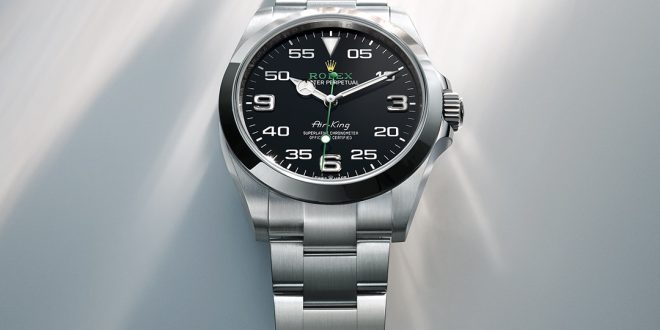The Rolex Air King is a timepiece steeped in aviation history and horological excellence. From its early days as a pilot’s watch to its recent redesign, the Air King reflects Rolex’s dedication to precision, functionality, and timeless design. This article explores the evolution of the Rolex Air King, tracing its origins, design transformations, and innovations that have solidified its position as one of Rolex’s most iconic and enduring watches.
Origins of the Rolex Air King: The Birth of an Icon
The story of the Rolex Air King began in the 1940s, during World War II. Rolex founder Hans Wilsdorf created the “Air” series as a tribute to the Royal Air Force pilots who relied on Rolex watches for their robustness and reliability. The collection included models such as the Air Lion, Air Giant, and Air Tiger, with the Air King eventually emerging as the most popular and enduring among them.
First introduced in 1945, the Air King Rolex quickly became associated with aviation. The watch’s large dial and simple, uncluttered design were suited to pilots who needed an easily readable timepiece in the cockpit. The watch’s emphasis on legibility and durability was a perfect match for its intended audience, and it gained a reputation as a no-nonsense, reliable companion.
The 1950s and 60s: A Design for the Modern Age
In the 1950s, the Rolex Air King began to solidify its design identity, evolving into a model with a more refined look. While earlier models featured an unassuming aesthetic, the Rolex Air King 5500 introduced in 1957 was a breakthrough. The Air King 5500 offered a 34mm stainless steel case, a size that was substantial for the era but maintained the Air King’s sleek and straightforward appeal.
The 5500 model was equipped with the Caliber 1520 or 1530 movement, known for its precision and reliability. The watch retained its simple dial design, featuring hour markers and the iconic “Air King” script. This period marked the Air King’s development into an elegant yet utilitarian timepiece, favored by pilots and civilians alike.
The 1970s and 80s: Continued Legacy and Popularity
By the 1970s, the Rolex Air King had established itself as a staple in the Rolex catalog. During this time, the brand made subtle changes to the design, focusing on enhancing the functionality and wearability of the watch without compromising its classic aesthetic. This era saw the introduction of the reference 5500 variants, which maintained the same case size and movement but offered updated materials and finishes to meet evolving tastes.
During the 1980s, Rolex also introduced models featuring a date function, such as the reference 5700, while keeping the traditional Air King style intact. The model’s versatility made it popular among collectors, and its reputation for reliability and timeless design allowed it to transcend trends.
2000s: Reimagining the Air King with Modern Touches
The Rolex Air King took on a fresh look in the 2000s, reflecting the watchmaker’s adaptation to modern tastes and technologies. In 2007, Rolex released the reference 114200, which featured several upgrades while maintaining the watch’s essential characteristics. This model included a 34mm case with an updated Caliber 3130 movement, providing enhanced accuracy and resistance to shocks and temperature changes.
Rolex also introduced an array of dial options for the 114200 model, including a blue, white, and pink dial, as well as an Explorer-style dial. The updated models gave a nod to contemporary style while preserving the understated elegance that had defined the Air King for decades.
The 2016 Redesign: A Bold New Direction
In 2016, Rolex surprised enthusiasts by unveiling a drastically redesigned Air King, reference 116900. This new model was an intentional departure from the classic Air King design, featuring a larger 40mm case, a bold dial, and distinctive numerals. The dial combined minute markers at 5-minute intervals and the Arabic numerals 3, 6, and 9, inspired by the Rolex Explorer, giving the a more modern and adventurous appearance.
One of the most notable features of the 116900 model was the green Rolex logo and yellow crown, elements that had not been seen before on a Rolex dial. The 2016 Air King incorporated the Caliber 3131 movement, ensuring the high level of precision and durability that Rolex fans had come to expect.
While some collectors were initially taken aback by the updated design, the 116900 model grew in popularity due to its unique appearance and high-performance specifications. The redesign signaled Rolex’s commitment to keeping the Air King relevant and appealing to a new generation of enthusiasts.
The 2022 Update: Honoring Tradition with Modern Advancements
The most recent update to the Air King in 2022 further refined the watch, blending the best of past and present. The 2022 model kept the 40mm case but introduced refined proportions, slimmer lugs, and an updated Oyster bracelet with an Easylink extension, enhancing wearability and comfort.
The latest Air King is powered by the Caliber 3230, a high-precision movement featuring Rolex’s Chronergy escapement for improved accuracy and efficiency. This model also introduced a new luminescent display, ensuring readability even in low light.
Why the Rolex Air King Remains Iconic
The Rolex Air King’s evolution reflects Rolex’s ability to blend heritage with innovation. As the watch has grown and changed over decades, it has managed to stay relevant without losing its essential character. From its origins as a pilot’s tool to its modern iteration, the Air King remains a testament to Rolex’s commitment to quality and timeless design.
For collectors, the Air King represents a piece of history and a symbol of Rolex’s dedication to precision and elegance. As the watch continues to evolve, it’s clear that the Rolex Air King will remain an essential model in the brand’s catalog, celebrated by enthusiasts for years to come
 Diverse Perspectives: Insights & Stories Exploring Ideas, Sharing Knowledge
Diverse Perspectives: Insights & Stories Exploring Ideas, Sharing Knowledge





